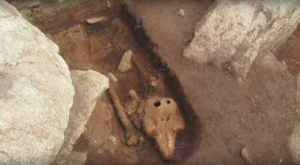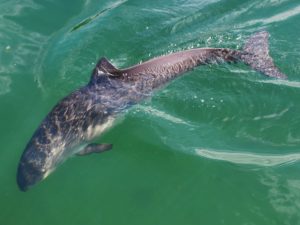
St. Gobnait is a patron saint of bees and beekeepers. Her fondness for bees suggests a calm and gentle nature. Tradition associates her with St. Abban and suggests she lived during the 6th century.
Gobnait was born in County Clare, but fled to Inis Oirr (Inisheer) the smallest of the Aran Islands to escape a family feud. There an angel appeared to her and told her to continue her journey until she should come to a place where nine deer were grazing. The angel told her this would be the “place of her resurrection.”
She traveled south in search of this place and her many stops are marked by churches and holy wells dedicated to her. At various stages of her journey Gobnait met with deer of varying numbers but it was only when she reached Ballyvourney in County Cork that she found the nine deer. They were grazing together on a rise overlooking the River Sullane and looking towards the Derrynasaggart Hills. This is where she settled, died and was buried “to await her resurrection.” The “resurrection place” is where the soul leaves the body. Celtic lore believed the soul left the body as a bee or butterfly.
St. Abban is said to have worked with her on the foundation of the convent and placed St. Gobnait over it as abbess. The nuns must have kept bees, since there are many stories about bees associated with the saint. In one story she cured one of her sick nuns using honey. Many accounts exist of how St. Gobnait prevented raiders or robbers from stealing cattle. Gobnait commanded the bees from the convent hives to drive them away. When a plague threatened the people, Gobnait walked to the village border and drew a line in the earth with her walking stick. The pestilence halted before reaching Ballyvourney.
The local chieftains, the O’Herlihys sought her help in a border war. One of her hives turned into a bronze helmet and the bees turned into soldiers. The O’Herlihys handed down the bronze helmet from one generation to another until it was lost in the 1700s. Another version has the beehive turning into a bell which then became Gobnait’s Bell.
For more on St. Gobnait: Pilgrimage in Medieval Ireland and Pixie’s Pocket.

I’m like a fish resting in the ocean. The waves rush over the little fish, and the great storms buffet; but this fish goes on swimming, knowing capture is impossible, and the storms just make this fish leap with more agility.
That’s what I do in this world that is a troubled sea. The great currents arrive, and I sail below them. I take shelter in You, God, and let them pass by. Then my soul finds wings in the two arms of Christ on the cross, and I rush up, Jesus, into your protection and saving grace.
When I stop and remember that I’m with You, I don’t fear the currents, I conquer them by navigating through them in Your Peace, and I come out of all storms unharmed.
St. Umilta of Faenza, (1226-1310), Sermons
In September 2017 archaeologists were wrapping up an excavation on the English Channel island of Chapelle Dom Hue when they made an unexpected and mystifying discovery. The excavation revealed a carefully cut grave plot, which the archaeologists reasonably assumed would hold the remains of a deceased human. Instead, they found that the grave contained the bones of a juvenile porpoise. 
The grave, carefully cut into the rocky soil on a high point of the island overlooking the sea, was constructed with the same techniques used for human graves.
The discovery was made at the site of a medieval monastic site, which was once occupied by monks searching for solitude. The team believes the bones date to the 13th or 14th century.
Philip de Jersey, a States of Guernsey archaeologist, said: “If they had eaten it or killed it for the blubber, why take the trouble to bury it? It was entirely consistent with a human burial, which is one of the most puzzling aspects,” de Jersey added. “The grave cut has been dug very carefully, with vertical sides and a flat base cut into the underlying bedrock. This has taken some considerable care and effort.”
He said it was the most unusual find in his 35-year career. “It’s very peculiar, I don’t know what to make of it. Why go to the trouble of burying a porpoise in what looks like a grave. It’s a wonderful surprise.”
Perhaps the answer is obvious: a wild porpoise developed a bond with one or more of the monks. Someone may have started to feed it, or found it stranded and helped it back into the sea. Or, the porpoise and the man saw each other at a certain time of day in the same spot and a companionship developed. When it died, or if it was killed, the porpoise was lovingly buried. 
See the excavation video.
There appears to be a disconnect in the beliefs of Catholics across the ideological spectrum on Care for Creation–all Creation.
Many good Catholics who care for the environment and would protest the killing of baby seals for pelts, agricultural killing of animal “pests,” and insist on humanely raised and harvested food, don’t blink when it comes to abortion on demand.
Many good Catholics who are “Pro-Life,” deeply concerned with promoting the sacredness of life, are indifferent or actively opposed to environmental protection as part of their “Culture of Life” ethos. Ecological degradation and pollution affect everyone, and it affects the poor disproportionately, especially children. 
Can each group reconsider the logic of their position?
Fr. James Kurzynski, who writes for The Catholic Astronomer, had an excellent blog post on the Catholic disconnect over what the Church teaches about ecology, and what Catholics believe and do.
He noted that despite the clear and unambiguous teaching of the last three popes (St. John Paul II, Benedict XVI and Pope Francis), there is a gap between what the Church teaches–and what her members practice–in regard to caring for all creation.






